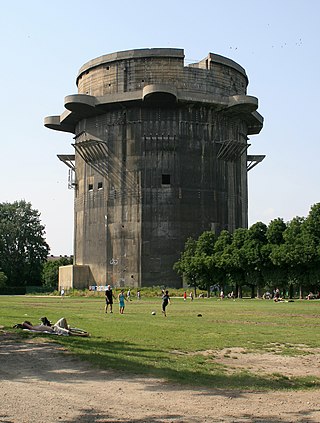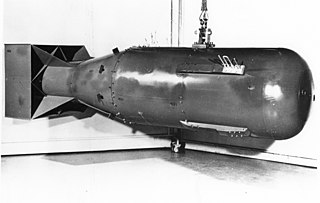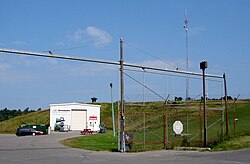
A bunker is a defensive military fortification designed to protect people and valued materials from falling bombs, artillery, or other attacks. Bunkers are almost always underground, in contrast to blockhouses which are mostly above ground. They were used extensively in World War I, World War II, and the Cold War for weapons facilities, command and control centers, and storage facilities. Bunkers can also be used as protection from tornadoes.

Emergency Government Headquarters is the name given for a system of nuclear fallout shelters built by the Government of Canada in the 1950s and 1960s as part of continuity of government planning at the height of the Cold War. Situated at strategic locations across the country, the largest of these shelters are popularly referred to as "Diefenbunkers", a nickname coined by federal opposition politicians during the early 1960s. The nickname was derived from the last name of the Prime Minister of the day, John Diefenbaker, who authorized their construction. Over fifty facilities were built along several designs for various classes of service.

Continuity of government (COG) is the principle of establishing defined procedures that allow a government to continue its essential operations in case of a catastrophic event such as nuclear war.

During the Cold War, Canada was one of the western powers playing a central role in the major alliances. It was an ally of the United States, but there were several foreign policy differences between the two countries over the course of the Cold War. Canada's peacekeeping role during the Cold War has played a major role in its positive global image. The country served in every UN peacekeeping effort from its inception in 1948 until 1989. This resulted in Canada provided the greatest amount of UN peacekeepers during the Cold War.
Canadian Forces Station Debert was a Canadian Forces station located in Debert, Nova Scotia. It was most recently used during the Cold War as a communications facility and was home to a "Regional Emergency Government Headquarters" (REGH) complex, more commonly known by their nickname "Diefenbunker."

Ottawa/Carp Airport or Carp Airport is located 1.2 nautical miles south of Carp, Ontario, Canada, a small village that is now part of Ottawa. Carp is the only airport in the Ottawa area where private hangar space is readily available, so it is a popular home base for local general aviation pilots.

Carp is a compact rural community in West Carleton-March Ward in the City of Ottawa, Ontario, Canada, located in the northwestern portion of the municipality on the Carp River. It is about 33 km (21 mi) from downtown Ottawa. Prior to amalgamation in 2001, Carp was located in the West Carleton Township.
The Office of Critical Infrastructure Protection and Emergency Preparedness (OCIPEP) is a Canadian government bureau that was created during Anne McLellan's tenure at the Department of Public Safety and Emergency Preparedness (PSEP).
Carp Road is an arterial road in Ottawa, Ontario, Canada that runs between Fitzroy Harbour and Stittsville, through the village of Carp. The road is located in the city's west end, beginning in Fitzroy Harbour at Galetta Side Road and ending in Stittsville at Stittsville Main Street. Most of the route is rural with the exception of Stittsville where the road travels in a residential development. Ottawa Regional Road #5 continues as Stittsville Main Street south of Carp Road, then becomes Huntley Road south of Stittsville toward the town of Richmond.

Atomic tourism or nuclear tourism is a form of tourism in which visitors witness nuclear tests or learn about the Atomic Age by traveling to significant sites in atomic history such as nuclear test reactors, museums with nuclear weapon artifacts, delivery vehicles, sites where atomic weapons were detonated, and nuclear power plants.

The Cold War Museum (Moscow) or Bunker GO-42, also known as "facility-02" (1947), CHZ-293 (1951), CHZ-572 (1953), and GO-42 (from 1980), and now Exhibition Complex Bunker-42, is a once-secret military complex, bunker, communication center in Moscow, Russia, near the underground Moscow Metro station Taganskaya. It has an area of 7,000 square metres (75,000 sq ft) and is situated at a depth of 65 metres (213 ft) below ground.

Barnton Quarry is a disused stone quarry in Corstorphine Hill, Clermiston, Edinburgh, Scotland. The site was later used as a military command centre, and is now being converted into a museum.

The Government Bunker(Regierungsbunker) in Germany, officially named Ausweichsitz der Verfassungsorgane des Bundes im Krisen- und Verteidigungsfall zur Wahrung von deren Funktionstüchtigkeit (AdVB), in English: "Emergency Seat of the Federal Constitutional Organs for the State of Crisis or State of Defence to Maintain their Ability to Function" was a massive underground complex built during the Cold War era to house the German government, parliament and enough federal personnel needed to keep the government working in the event of war or severe crisis. Located only about 25 kilometres (16 mi) south of Bonn, Germany, in the Ahr Valley between the towns of Ahrweiler and Dernau, it was one of the best kept secrets of West Germany. It was built between 1960 and 1972 inside two abandoned railway tunnels that were built as part of the Strategic Railway, maintained and kept in a working condition for about 30 years and decommissioned in 1997. A small part of the once-secret site is now open to the public as Government Bunker Documentation Site, while the vast majority is abandoned and sealed.

Royal Air Force Holmpton or more simply RAF Holmpton is a former Royal Air Force Cold War era nuclear bunker that was built in the 1950s as an early warning radar station as part of the ROTOR Radar Defence Programme. Located just south of the village of Holmpton, in the East Riding of Yorkshire, England, RAF Holmpton remained a part of the Defence Estate right up to 8 December 2014 when it was sold into private ownership after 62 years of military service.

National Defence Headquarters (NDHQ) was created through the integration of the Canadian Armed Forces Headquarters with the civilian Department of National Defence (DND) staff in October of 1972. NDHQ is not a specific location, but is instead housed throughout a collection of offices in buildings across the National Capital Region, although it is most commonly identified with the Major-General George R Pearkes Building on Colonel By Drive in Ottawa.
Many countries around the world have civil defense organizations dedicated to protecting civilians from military attacks and providing rescue services after widespread disasters. In most countries, civil defense is a government-managed and often volunteer-staffed organization.
The Dunrobin Detachment was a military-operated radio communications receiver station linked by land line to CFS Carp located on the corner of Dunrobin Road and Vance's Side Road NW of Dunrobin, Ontario. A second antenna receiver site was located further West near Almonte, Ontario; the Almonte Detachment. The detachment was unmanned and the location primarily used as a remote antenna farm. After the end of the Cold War, CFS Carp was decommissioned and the antenna site was no longer needed.
The CFS Carp Richardson Detachment was a military operated radio communications transmitter station linked by landline to CFS Carp located off Lanark County Road 10 East of Perth, Ontario. The detachment was built with a hardened two story underground bunker built to accommodate the Signals personnel needed to operate the transmitter in case of war, as well as a mess hall, sleeping quarters, offices, decontamination facilities, and its own power generation facilities. Its location was chosen to be far enough away from CFS Carp to ensure survivability in the case of a nuclear strike against CFS Carp, and to reduce the risk of interference from its twenty powerful radio transmitters.

The Almonte Detachment was a military-operated radio communications receiver station linked by land line to CFS Carp located in Burnt Lands alvar off Lanark County Road 49 East of Almonte, Ontario, Canada. A second antenna receiver site was located further east near Dunrobin, Ontario; the Dunrobin Detachment. Both of these sites were linked to CFS Carp Richardson Detachment, which was a remote-operated transmitting site. CFS Carp Almonte Detachment was unmanned and the location primarily used as a remote antenna farm. After the end of the Cold War, CFS Carp was decommissioned and the antenna site was no longer needed.

















